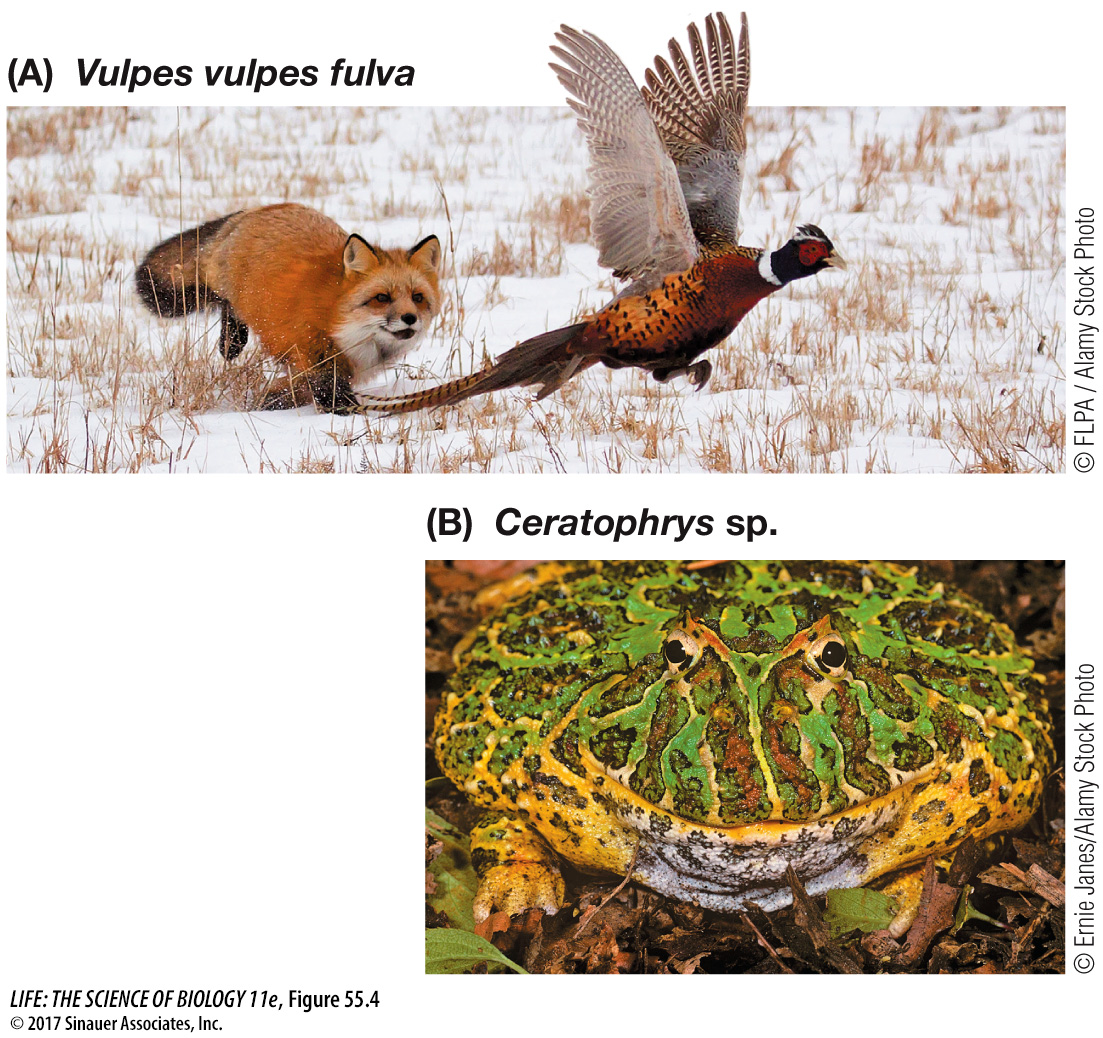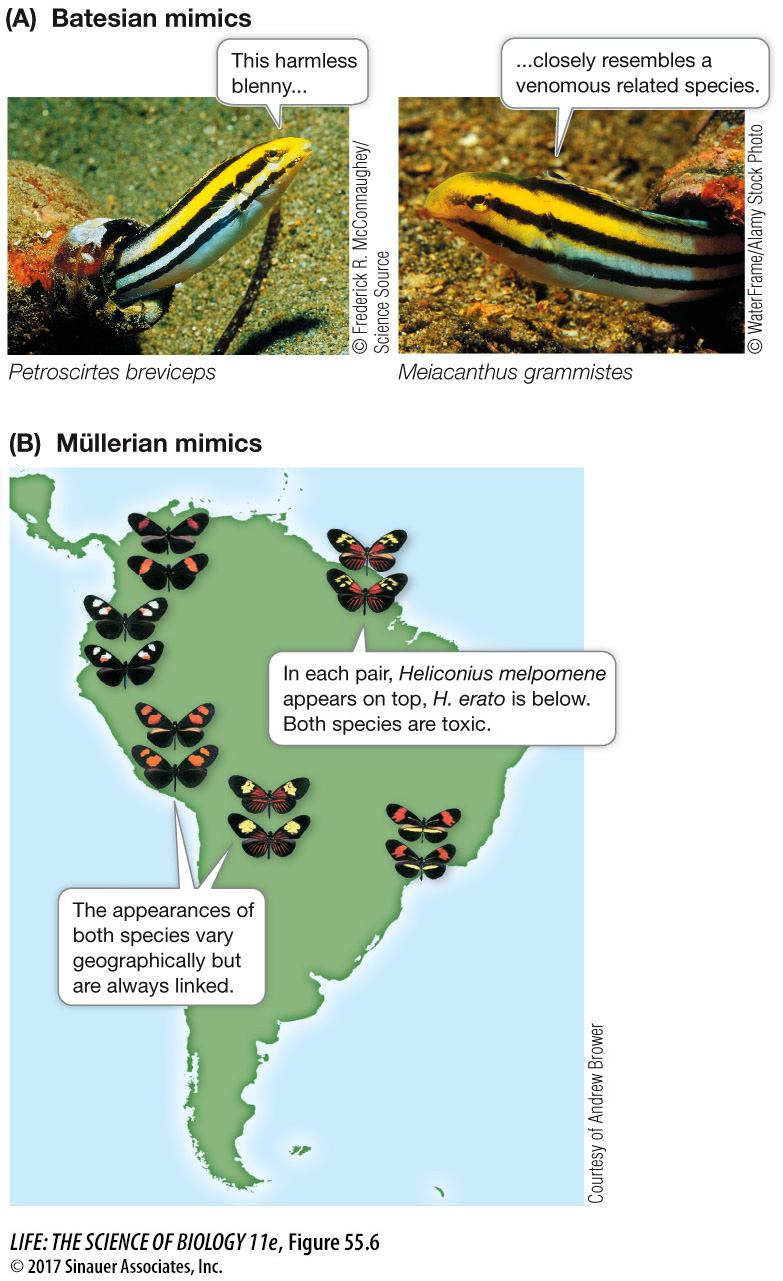Carnivory results in a range of capture and avoidance mechanisms
Given that carnivores almost always kill the prey they consume, the interests of both predator and prey are at stake: the best strategy for carnivores is to maximize their ability to capture and consume prey while the best strategy for prey is to minimize the likelihood of being eaten. We first consider the strategies carnivores use to obtain food and then examine how prey avoid being eaten.
What strategies do carnivores use to obtain food? The success of carnivores depends on balancing the cost of pursuing, capturing, and handling prey against the energetic benefit of consuming them, as discussed in Key Concept 52.4. At one extreme, carnivores use strength and swiftness to actively search for and capture high-

Prey species have in turn developed a variety of defenses against predators. Some escape from predators simply by flying or running away. Others have morphological defenses; tough skin, shells, spines, or hair can foil even a determined predator (Figure 55.5A). Various other defenses that prey have evolved to avoid capture are described below.

AVOIDING DETECTION Prey species can often escape predators by hiding. One form of hiding is camouflage, also known as crypsis. Crypsis allows species to resemble objects that their predators consider inedible. The katydid in Figure 55.5B, for example, looks very much like a dead leaf, even down to the likeness of a spot of fungal decay.
Because the vision of many types of predators is adapted to spot moving prey, many prey species simply stop moving if they are being pursued. “Playing possum,” a term that is sometimes applied to this strategy, refers to the ability of opposums to simulate death.
CHEMICAL DEFENSES Many animals use chemical defenses to escape or repel their predators. Chemical defenses are generally used by animal prey that are small, weak, sessile, or otherwise unprotected. Many insects produce sprays, oozes, or froths when attacked. Bombardier beetles, for example, eject a hot (100°C) noxious chemical spray from the tip of their abdomen that can be fatal to attacking insects.
Media Clip 55.1 Bombardier Beetle Sprays Its Enemies
Activity 55.2 Coevolution Simulation
Activity 55.3 Predator-
Predators may evolve adaptions to overcome their prey’s chemical defenses, as you saw in the case of the rough-
WARNING SIGNALS Some prey species that defend themselves with toxic chemicals advertise that fact with a warning signal. Warning signals may be visual (many toxic species are brightly colored) or acoustical (the rattlesnake’s warning rattle, for example), depending on what sensory cues their predators use to find prey.
Many toxic prey, such as the nudibranchs and frogs in Figures 55.5C and D, sport bright colors or striking patterns to protect themselves against visually orienting predators. Such warning coloration increases the probability that a predator will learn to recognize and avoid the toxic species. Some vertebrate predators that rely on visual cues can learn quickly to associate certain color patterns with an unpleasant feeding experience.
MIMICRY SYSTEMS There are two general types of mimicry systems that have evolved repeatedly in nature: Batesian mimicry and Müllerian mimicry. In Batesian mimicry, a benign, edible species (the mimic) closely resembles a dangerous, toxic species (the model). The mimic benefits from the avoidance behavior of predators of the model (Figure 55.6A). In Müllerian mimicry, two or more species converge on a common warning signal; all benefit from providing a stronger recognition signal to predators. Many of the Neotropical longwing butterflies (Heliconius), which as caterpillars feed on toxic passionflower plants and incorporate the plant toxins into their bodies, are Müllerian mimics. Heliconius species living together in a particular geographic region are likely to have similar coloration and share a common warning pattern (Figure 55.6B). Genome sequencing of Heliconius Müllerian mimics has identified one gene, optix, that codes for a transcription factor that can, by changing gene expression patterns, create the same color patterns in Heliconius species that are not very closely related.

BEHAVORIAL MECHANISMS Prey often use behavioral mechanisms to avoid predation. For example, as you saw in Key Concept 52.6 and Figure 52.21, group behaviors such as flocking and alarm vocalizations can provide protection from predators. In the lionfish example introduced in the chapter opening story, the evolutionary change in behavior that predator and prey may experience has not yet had time to develop. In Investigating Life: The Lionfish King we describe research showing that the small reef-